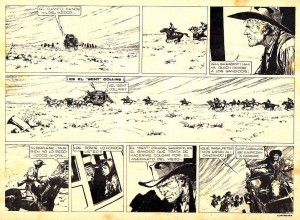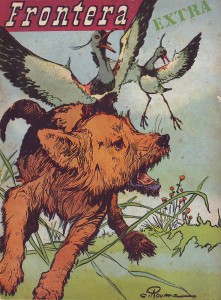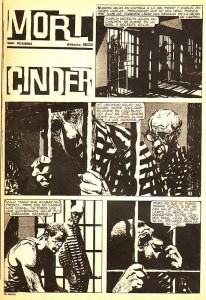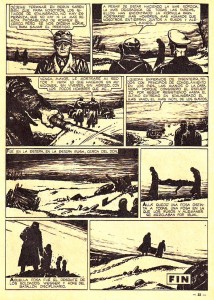Héctor Germán Oesterheld’s and Francisco Solano López’s “Enterradores” (gravediggers)
A curious thing happened when Argentinian scriptwriter Héctor Germán Oesterheld found his own comics publishing house, Editorial Frontera. For a brief period of time, 1957 – 1963, mainstream adolescent comics raised much above the business as usual, pervasive formulaic dreck. Oesterheld proved to me a very simple and often forgotten truth: it’s easy to dismiss a whole category if we base our judgment on the worst examples (usually those are the only ones that the judges know about). It’s easy to debase something when the judge is socially much above the subject of her/his scorn; in these circumstances s/he can only be applauded by her/his peers while all outraged reactions can’t be heard outside of the attacked subculture.
I don’t defend adolescent comics, mind you, I’m just saying that when the best comics writer ever decided do try a hand at this particular genre (if we can call it that) the inevitable happened. Here’s what he had to say in Hora Cero Suplemento semanal (zero hour weekly supplement) # 1 (September 4, 1957):
There are bad comics when they’re badly done only. Denying comics all together, condemning them as a whole, is as irrational as denying cinema all together because there are bad films. Or condemning literature because there are bad books. There are, unfortunately in a huge ratio, lots of bad comics. But these don’t disqualify the good ones. On the contrary, by comparison, they should underline their quality. […]
Oesterheld is a German family name and Héctor inherited a German tradition which, according to Christian Gasser (in the Lisbon comics convention catalog, 2003) dates from the enlightenment:
This didactic interpretation of literature is a product of the 18th century. At that time, the qualities of literature and art were used to educate and morally elevate the common people. Meanwhile, these efforts became obsolete in literature, but not in the restricted domain of children’s literature where people continue to ask: “Very well, what can a child learn from this book?” The pedagogic function continues to be overrated.
Oesterheld viewed the, then, popular medium of comics as an opportunity to reach hundreds of thousands of children and adolescents. At a certain point he felt the need to put the following warning on the cover of Hora Cero Suplemento Semanal: “Historietas para mayores de 14 años” (comics for those who are older than 14). The anti-comics crusade was still on and he didn’t want any trouble. Anyway, he wanted to both educate and entertain. What he meant by “educate” wasn’t exactly what may be on our minds today though…
He aimed at four goals: (1) to be accurate with his data (pedagogic texts about warfare punctuated his comics; he wrote stories in a lot of genres – Western, Science-Fiction, Historical, Noir –, but War – WW2, to be exact – remained the bulk of his magazines’ content); (2) he didn’t want to edulcorate reality or bowdlerize his stories; (3) he wanted to convey moral values of self-sacrifice, unselfishness, team work (he strongly opposed the individual macho hero as he – it’s usually a “he” – is seen by North American mass artists; ditto the glorification of violence… besides, the main character is usually someone socially “invisible” who reacts unexpectedly in a stressful situation); (4) linked to (2): Oesterheld didn’t want to hide what’s darker in the human condition, but, at his best (he produced hundreds of stories, so, lots and lots of them aren’t that good) he was never Manichean.
Four great draftsmen drew Oesterheld’s stories at Editorial Frontera before working (immigrating even) exclusively for the UK. After these artists disbanded the graphic quality of Frontera’s stories dwindled dramatically. Not even a young José Muñoz could equal them:
Hugo Pratt:
Hora Cero Extra! # 4 October, 1958.
Hugo Pratt did very rare unprejudiced portraits of black people in the 50s. In this Hora Cero Extra! cover he illustrated a story by Oesterheld about Senegalese soldiers fighting for France during WW2.
Arturo del Castillo:
Hora Cero Suplemento Semanal # 58, October 8, 1958.
An impressive Western scene from “Randall.” Castillo would do for the UK the best The Man in the Iron Mask comics illustrations ever.
Carlos Roume:
Frontera Extra # 7, May 1959.
Roume was a great animal artist. In this Frontera Extra cover he drew Pichi, the Pampa dog. A story scripted by Héctor’s brother, Jorge.
Alberto Breccia:
Misterix # 749, March 22, 1963.
Alberto Breccia and Héctor Germán Oesterheld’s Mort Cinder (a series that, in my view, isn’t as good as Ernie Pike) remains one of the most famous of Oesterheld’s creations (along with Argentinian cultural icon: El Eternauta – the eternaut). This doesn’t surprise me because of comics fans’ bent for fantasy. Even so the story to which the above page belongs, “En la penitenciaria: Marlin” (in the penitentiary: Marlin), is one of the series’ best ones.
I immersed myself in Oesterheld’s oeuvre for the last year. Reading hundreds of his stories I can safely say that he could have been one of those world famous South American writers like Jorge Luis Borges. Borges and Oesterheld knew each other and used to take walks together. Oesterheld was an inventive plotter and a purveyor of ideas and great phrases. Even when the story is no good at all (as I said, he produced too much) a phrase sparkles suddenly making the reading worthwhile.
I stumbled upon lots of Oesterheld’s great stories, but I had to choose one for this Stumbling. I chose “Enterradores.” In it a German major freshly arrived from Berlin to the Stalingrad front is shocked when he discovers that two German soldiers (Wesser and Hofe) of the disciplinary battalion (whose mission is to bury corpses) are burying Russians and Germans together:
Hora Cero Extra! # 1, April 1958.
The drawings are by Francisco Solano López. To be honest I don’t like Solano’s drawings as much as I like the work of those four artists above. I find his understanding of the human figure a bit strange and his lines a bit heavy and formless sometimes. Even so it seems to me that he captured the facial expressions of the veterans well in contrast with the major’s. The overall darkness of the atmosphere is more than adequate to convey the theme of the story.
The captain explains to the major how desperate the situation is (he wants to excuse the two men’s lack of discipline). Here’s what Oeserheld wrote in the last two strips: “It was in the Steppe, near the Don. / There stayed a shared grave different from all the others. A grave in which Russians and Germans mixed. / That grave was the revenge of soldiers Wesser and Hofe of the disciplinarian battalion.” Equally impressive are the eerie shadows walking into oblivion at the end…
Can you imagine such a story in a children’s comic today? It wasn’t even suitable for a children’s comic back in the 50s. And yet, Argentinian kids bought Hora Cero and Frontera in their various incarnations. Judging from Oesterheld’s example, maybe I’m not against children’s comics… maybe I’m against children’s comics that insult their readers’ intelligence, that’s all…






The Castillo and Roume art is just beautiful. Thanks for posting this Domingos.
You’re welcome Noah. Roume is another one of those comics artists that are underrated because they’re not from the US, France, Belgium and Japan.
Castillo too, of course… Breccia is better known because he published in France and Italy. He’s also one of the few who really tried to explore various innovative drawing techniques.
Lovely post.
You didn’t mention Oesterheld’s ultimate fate…a victim of Fascism.
Hi Alex:
Yes he was. Him, his four daughters (aged 18 – 21) and two sons-in-law are 7 of the roughly 30.000 who disappeared in the late 70s. One grandson was adopted and was never recovered by his grandmother Elsa. You may read all about it, here: http://tinyurl.com/3y2ax7r But this bit: “We did away with him because he wrote the most beautiful story of Ché Guevara ever done” is just an embellishment. The Oesterheld family “disappeared” because they were members of Montoneros. A political / military organization.
Oh, and thanks!…
Is there any progress on him as one of the “disappeared”? Any information?
Argentina has yet to come to terms with its vile past.
But then, as a Frenchman, who am I to lecture? France has finally dealt with its ignoble collaboration with Nazi Germany. (Only took about 60 years.)
It still won’t deal with its wartime collaboration with Japan. As far as I know, only one French author– Morgan Sportès– has even brought up the subject, and he was a) hooted down, and b) ignored.
No progress whatsoever… These things aren’t easy to deal with. Either people open old wounds or they forget and go on with their lives. Usually it’s the latter that happens, but the victims can’t help feeling that an injustice is being made to them.
Anyway, the fact is that the Montoneros was a violent organization. Elsa drew the line right there, the rest of the family didn’t and they all payed a heavy price.
Montoneros: http://en.wikipedia.org/wiki/Montoneros
This is just to correct what I say above. Elsa Oesterheld didn’t lose one grandson, but two (I’m not sure about their gender either). They were adopted after their family was killed. Elsa recovered two other grandsons who are adults today: Fernando Araldi Oesterheld, Martín Miguel Mortola Oesterheld.
It was too late by then (1982), but after being aware of Oesterheld’s kidnapping Hergé wrote to general Gualtieri:
http://www.entrecomics.com/?p=11551
Hi!
Just a ‘thank you’ from a faithful reader for the nice post and a question:
You copied the comics you posted from the originals, right? I have been trying to locate more works by Castillo and Roume but failed miserably …
Hi Federico:
You’re welcome and thank you for your interest!
If by “originals” you mean the comics’ first editions the answer is: yes I did. I don’t know exactly which Castillo comics do you own, so, I don’t know which comics you mean when you say “more works,” but, anyway, I have bad news and very good news:
Castillo’s work for Frontera is almost impossible to find nowadays. I tried to help publish _Randall_ in Spain to no avail (unfortunately I’m very pessimistic re. this great comic’s reprints). With a bit of patience you may find old issues of _Skorpio_ magazine in Argentina (in Mercado Libre, for instance), but the writer was no longer Oesterheld during the seventies and eighties (of course). Italy’s Eura Publishing house is another possibility (Edizione Milone are also very rare): http://tinyurl.com/39vbd4m
The good news are that The Book Palace will publish Castillo’s great version of _The Three Musketeers_!
It’s the 6th book in this list: http://tinyurl.com/37gyv4v (I hope that the cover price will not be a bad surprise…)
As for Roume you may find old British comics drawn by him on the Internet (as part of the _Cowboy Picture Library_, for instance), but his best comics were created for the Argentinian market and are very difficult to find.
Thanks for the reply and the links!
By ‘more works’ I actually meant ‘any’: I am an experienced book-buyer and bibliophile, but argentinian comic books (or rather, their reprints) proved the most difficult and frustrating buying experience I have ever had (I am relatively new to comics).
So many thanks again!
Hi again Federico:
Unfortunately Argentinian comics publishers can’t publish anything by Castillo (that’s why I said that I’m pessimistic re. _Randall_’s future reprints). I don’t understand why they don’t reprint anything by Roume (maybe there’s the same rights trouble or maybe they find that _Patria Vieja_ – the old homeland – is just that: outdated; I really don’t know…). But you may find reprints by another great (the best of them all, methinks), Alberto Breccia. Here’s a reprint of Oesterheld and Breccia’s _Mort Cinder_: http://tinyurl.com/28hwhng
Here’s also a reprint of _El Eternauta_: http://tinyurl.com/2d3lme8
French editions of Argentinian comics are the best bet (if you can read French, that is; you may also want to search for Muñoz and Sampayo): http://tinyurl.com/29lj7ts
Colihue in Argentina also published a few things: http://tinyurl.com/27ybfye
These aren’t very good editions though.
A Castillo book for sale on eBay: http://tinyurl.com/3a7xlgq
I resume this thread to point out a book by Arturo del Castillo available in Italy:
http://tinyurl.com/3s5qknp
The publisher’s website does not even mention del Castillo’s name in full, but the book is nicely done: it has the most informative introduction I have ever read about del Castillo’s work, and it collects 6 episodes of the ‘Kendall’ character, written by Dami. The panels seem to be in their original format – except maybe the first episode, which was maybe pubished in horizontal format, according to the cover of the original publication (reproduced in the book).
Not a bad book at all, and del Castillo’s artwork is really amazing! Some old men’s heads are really wonderful! Thanks again for introducing me to this great artist.
Federico
You’re welcome Federico! And thanks!…
Fifty years ago we were already there, another five years passed by… and Los Enterradores, Amapola Negra(I’ve worked there with my brush plenty of water with black ink doing clouds, mechanical interiors of the B 17, Messerschmitts and lots and lots of used leather jackets…to search the right light on them was, is, a giant pleasure) El Eternauta, El Cuaderno Rojo, are part of my central memories.
I’m so touched by your interest, respect and conmotion around the superbly well done works of my masters.
Roume camina con Del Castillo
por las calles de mis barrios,
el polvo de las Pampas y del Painted Desert
entra en la ciudad,
Solano, Pratt y Breccia los esperan
en el Bar La Comedia, Corrientes esquina Paranà,
Oesterheld està llegando con su tìmida sonrisa.
Way too late, I’m afraid, but just today I saw your comment Mr. Muñoz! What can I say? I’m always thrilled to hear from you. And what a great poem! Thanks!